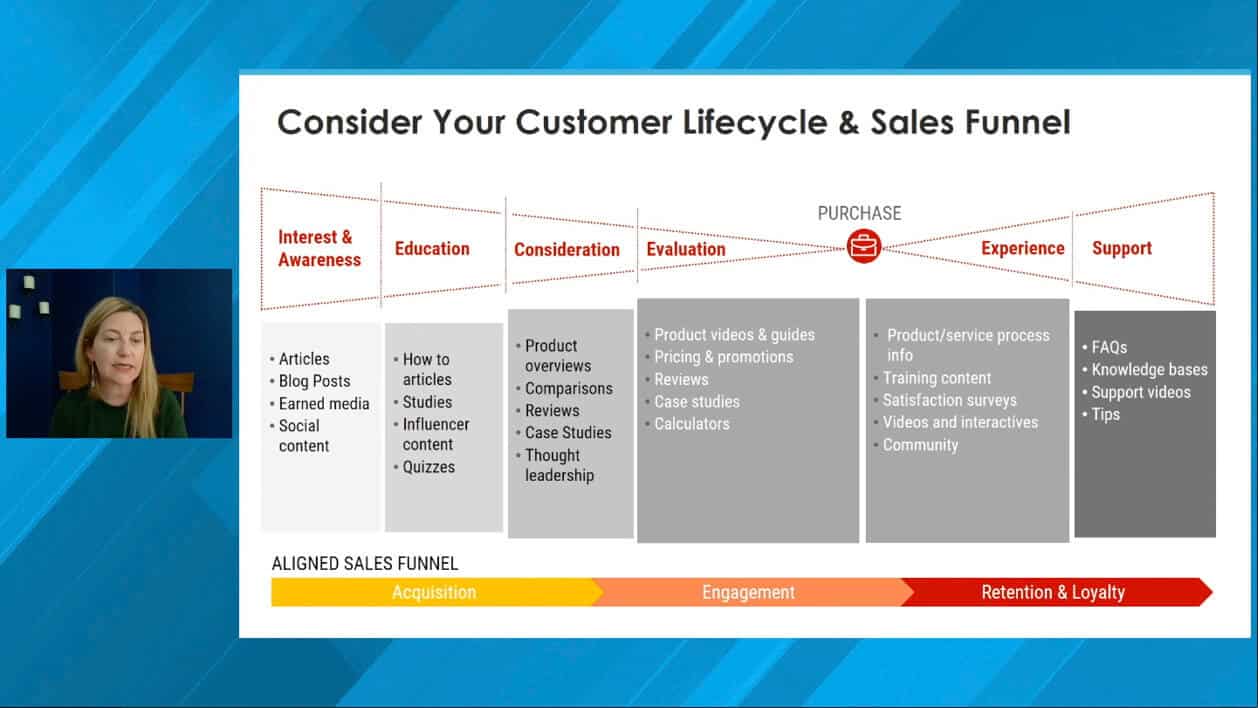Businesses turn to content marketing because it can be an effective method for building brand awareness and guiding customers through their sales funnel. Yet, many have been unable to capitalize on their content marketing initiatives because they haven’t covered all aspects of the customer journey, didn’t keep track of their assets and wasted resources on duplicate content, failed to create unique content or were simply unsuccessful with their outreach efforts.
In her session at SMX Convert, Eve Sangenito, director at Perficient, shared her comprehensive content strategy to engage potential customers at every point in their journey and generate backlinks for greater discoverability and higher rankings.
Understanding the customer and mapping their journey
Your content should exist to serve your brand by serving your audience — that should always be at the center of your planning and execution. “It isn’t so much about what you want to tell your audience; it’s what you understand they want to learn and what’s going to be helpful for them to learn more about your solutions and/or about your industry as a whole,” Sangenito said, adding “Just knowing where they’re coming from is one of the key elements you should be focused on.”

Mapping the journey that a customer typically goes through can also help you build your audience personas while identifying opportunities to answer common questions at each phase of the journey.
“From your business’s standpoint, you want to think about how the customer lifecycle plays into the sales funnel because you’re trying to build relationships with target audiences and target buyers,” Sangenito said.
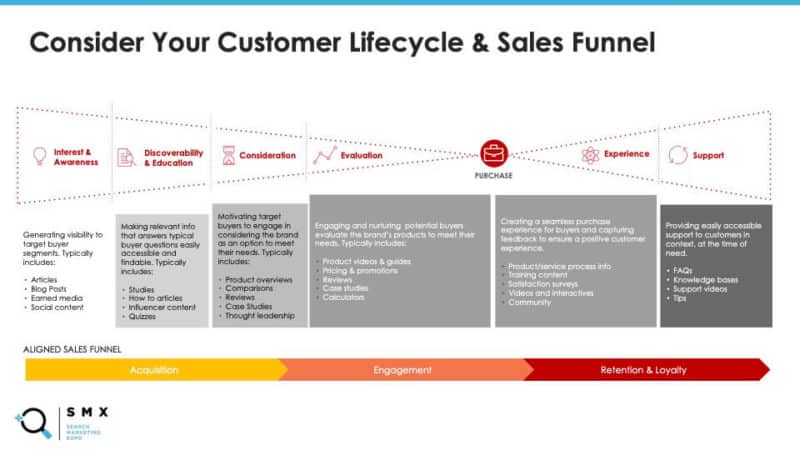
What audiences typically search for at each stage of the funnel. “We tend to see informational queries when someone is in their awareness phase,” she said, providing the following examples of questions a consumer at the top of the funnel may be asking: “What are the options available to me? What are people saying about those options? How are other people in the market feeling about the information that’s put forth by this organization?”
In the next stage of the funnel, consumers typically seek to educate themselves via how-to articles, studies and influencers. When a potential customer gets to the consideration and evaluation phases, they’re narrowing their options, reading reviews or case studies and comparing prices.
The customer lifecycle continues after the purchase as well. Teaching your customers how to make the most out of your products or services can enrich their experience and providing accessible support via FAQs or videos, for example, will also help to maximize your chances of turning a first-time buyer into a loyal customer.
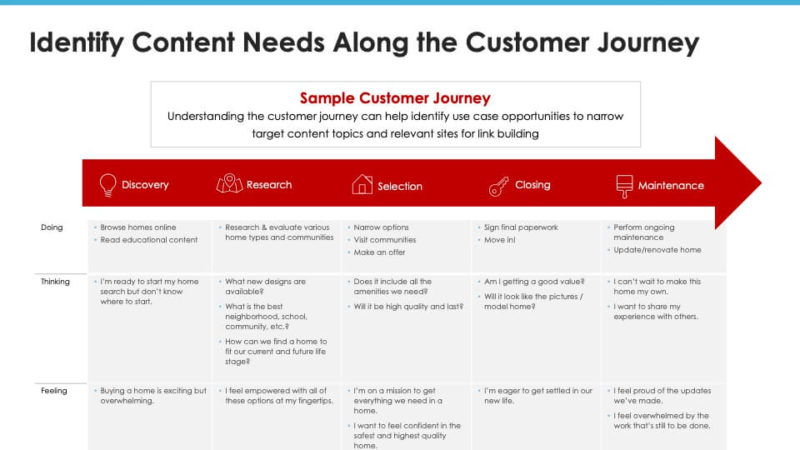
Once you’ve mapped the journey for a particular persona, you should leverage that map to develop pillar and supporting content topics. This “content topic universe” (more on that below), will help you steer clear of irrelevant topics that may end up leaving your audience with more questions rather than guiding them further down the funnel.
Developing your content topic universe
The personas you’ve created can act as the locus of the content topic universe, enabling you to brainstorm themes that are specific to that type of customer.
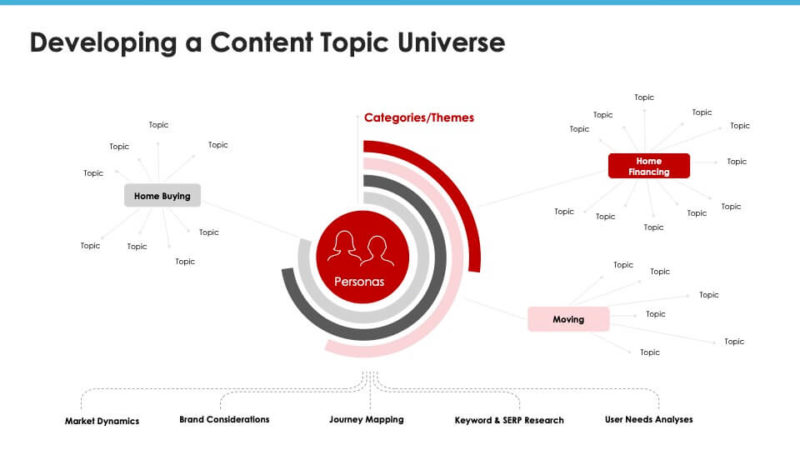
“What are some of the common questions based on where they are in their life stages?,” Sangenito asked, using prospective home buyers as an example, “Are they buying a home for retirement? Are they buying a home for the first time?” Marketers can create variations of those topics for different personas and branch out to answer follow-up questions that customers are likely to ask.
Cut down on wasted resources by managing your assets. Taking and maintaining an inventory of your existing content helps you understand what assets you already have at your disposal. This can minimize resources wasted on duplicate content by, for example, helping you distinguish what assets can be updated versus what needs to be created from scratch. “Also, knowing what you have allows you to see the gaps and where your editorial calendar can go in the future,” Sangenito said.
Injecting your brand and goals into the content. Brand and market insights can inform how you actually create the content and, consequently, help to shape what that content does for your business: This is where you can insert your brand’s guidelines to ensure a consistent tone across your content marketing. You can also address topical issues in your industry, differentiate your offerings or tailor your content for a specific purpose (like social sharing), for example.
Creating unique, optimized content
Validate your topic. Before you start writing or creating the content, you’ll first need to confirm that the topic is relevant and of interest to your audience. You can validate your topic while conducting keyword research by looking at the search volume associated with the keywords you’d be targeting.
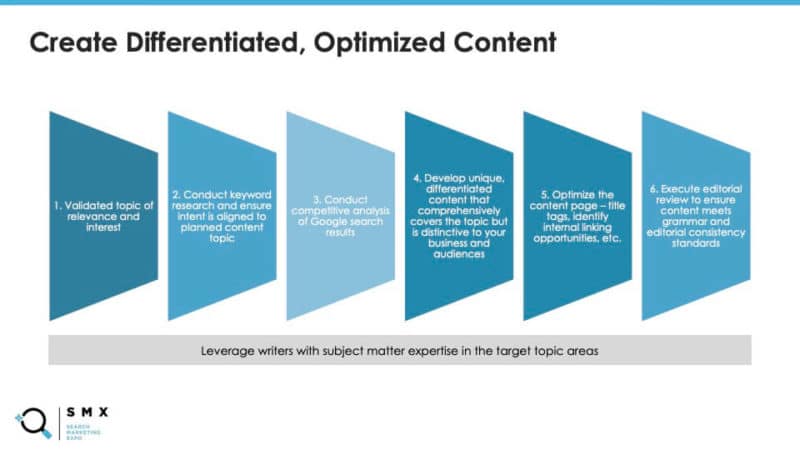
Align with search intent. Understanding intent for your target keywords is also a critical step: “You can look at the SERP and you can start to understand what kinds of content are being surfaced for someone who’s searching for this topic and you can see whether or not that would fit what you’re trying to accomplish,” Sangenito said. This is also an opportunity to do some research on the competition and how they’re performing in the search results: “[If] what’s being featured [in the search results] is all coming from a single set of organizations, there might be an opportunity to diversify by having your organization produce content on that [topic],” she added.
Differentiating your content. Emulating the top-performing search result is a pitfall you’ll want to avoid. Your competitive analysis should reveal ways to go beyond what’s already out there, enabling you to differentiate your content and your brand. Getting quotes from experts, hiring writers that specialize in the topic or even formatting (an infographic might appeal to your audience more than a listicle, for example) could be meaningful ways to differentiate.
After you’ve compiled your content brief (informed by your personas, journey map, keyword research and competitive analysis), it’s time to pass it on to your content writer or creator. “Make sure that your authors have the knowledge and expertise to write about those topics because the nuances of how they write about it versus the generalist who’s just doing research on their own can really come through and affect the content,” Sangenito said.
Optimizing and editing. Once you have your draft, SEO best practices, such as internal linking, title tag optimization and structured data, can be applied so that your audience can find more information related to your content and continue to move along the customer journey. It’s also important to conduct an editorial review before publishing to ensure that your content conveys professionalism, adheres to your brand tone and serves your business and your readers the way it should.
Building links for more traffic and better rankings
Determine what’s link-worthy. When building backlinks, it’s best to focus on promoting the most relevant and highest quality content for the audience you’re trying to tap into.

Sangenito recommends that marketers ask themselves the questions that the people they’re outreaching to are probably asking: “What’s the scope and scale? How relevant is this content that you want me to link? How many people does it potentially affect or how engaged is the base of people that it will affect and how much will they want to read it? What is that impact potential?”
Content that is able to engage audiences on an emotional level can also be an important factor in whether or not you earn the backlink.
Timing can influence how many backlinks you’re able to attract, as well. “There’s relevance to linking out to both evergreen content or seasonal content, but thinking about that in terms of when you actually publish content to generate organic links, or outreach for it, is something that you should keep top-of-mind,” she added.
Link building strategies. Link building can help you expand your discoverability, drive traffic to the most valuable assets on your site and create a sense of trustworthiness for your brand if you’re able to earn backlinks from authoritative publications. There are numerous ways to approach link building — Sangenito highlighted a few strategies, as shown below.
“You can do tactical elements, like understanding if you have broken inbound links and seeing if you can outreach to the sites that are linking to you to see if they could be updating them,” Sangenito said, adding that PR coverage may be another opportunity to turn a brand mention into a link if it isn’t one already. Reviewing your competitor’s backlinks can reveal sites that may also be open to linking to your brand as well.
Resource-based link building, which involves promoting an existing piece of content that might add value for users of other sites, can also be an effective approach depending on the quality of your content and your outreach skills.
Content marketing isn’t a “one-and-done” tactic
Once the content is created and the backlinks are earned, you’ll want to keep your momentum going by periodically auditing your content inventory and updating assets when appropriate. This will help keep the content that you’ve worked so hard to create and earn backlinks for up-to-date. That way, the content will continue to serve your audience and you can keep performing outreach for that particular asset, further strengthening your brand’s reputation, which should also mean more conversions for your business.
Want to see the whole session? Sign up to watch the entire SMX Convert learning journey on-demand.
